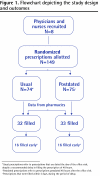Postdated versus usual delayed antibiotic prescriptions in primary care: Reduction in antibiotic use for acute respiratory infections?
- PMID: 20944049
- PMCID: PMC2954088
Postdated versus usual delayed antibiotic prescriptions in primary care: Reduction in antibiotic use for acute respiratory infections?
Abstract
Objective: To determine whether postdating delayed antibiotic prescriptions results in a further decrease (over usual delayed prescriptions) in antibiotic use.
Design: Randomized controlled trial.
Setting: A small rural town in Newfoundland and Labrador.
Participants: A total of 149 consecutive adult primary care patients who presented with acute upper respiratory tract infections.
Intervention: Delayed prescriptions for patients who might require antibiotics were randomly dated either the day of the office visit (ie, the usual group) or 2 days later (ie, the postdated group).
Main outcome measures: Whether or not the prescriptions were filled and the time it took for the patients to fill the prescriptions were noted by the 4 local pharmacies and relayed to the investigators.
Results: In total, 149 delayed antibiotic prescriptions were written, 1 per patient. Of the 74 usual delayed prescriptions given out, 32 (43.2%) were filled; of the 75 postdated delayed prescriptions given out, 33 (44.0%) were filled. Sixteen patients from each group filled their delayed prescriptions earlier than the recommended 48 hours. Statistical analyses-χ² tests to compare the rates of antibiotic use between the 2 groups and t tests to compare the mean time to fill the prescription between the 2 groups-indicated that these results were not significant (P > .05).
Conclusion: Although delayed prescriptions reduce the rate of antibiotic use, postdating the delayed prescription does not seem to lead to further reduction in use.
OBJECTIF: Déterminer si le fait de postdater les prescriptions d’antibiotiques différées entraîne une plus grande réduction de l’utilisation des antibiotiques que les prescriptions différées habituelles..
TYPE D’ÉTUDE: Essai randomisé avec témoins.
CONTEXTE: Une petite localité rurale de Terre-Neuve et Labrador.
PARTICIPANTS: Un total de 149 patients adultes consécutifs en médecine primaire consultant pour une infection des voies respiratoires aigüe.
INTERVENTION: De façon aléatoire, les prescriptions différées pour les patients susceptibles de nécessiter ultérieurement des antibiotiques ont été préparées en date de la journée de la consultation (i. e. mode habituel) ou pour 2 jours plus tard (groupe postdaté).
PRINCIPAUX PARAMÈTRES MESURÉS: Les 4 pharmacies locales ont noté si les prescriptions ont été remplies ou non, et le temps qu’il a fallu aux patients pour les pour la faire remplir. Ces renseignements ont été transmis aux chercheurs.
RÉSULTATS: On a fait un total de 149 prescriptions différées d’antibiotiques, une par patient. Sur les 74 prescriptions différées habituelles, 32 (43,2 %) ont été remplies; sur les 75 prescriptions différées postdatées, 33 (44 %) ont été remplies. Seize patients de chacun des groupes ont fait remplir leur prescription avant le délai recommandé de 48 heures. L’analyse statistique – comparaison par tests de χ2 des taux d’utilisation d’antibiotiques entre les 2 groupes et par tests de t pour les moyennes des délais pour remplir les prescriptions - indiquait que ces résultats n’étaient pas significatifs (P > .05).
CONCLUSION: Même si les prescriptions différées diminuent le taux de consommation d’antibiotiques, le fait de postdater ces prescriptions ne semble pas diminuer davantage cette utilisation.
Figures

References
-
- Macfarlane J, Lewis SA, Macfarlane R, Holmes W. Contemporary use of antibiotics in adults presenting with acute respiratory tract infection in general practice in the UK: implications for developing implementation guidelines. Respir Med. 1997;91:427–33. - PubMed
-
- Nyquist AC, Gonzales R, Steiner JF, Sande MA. Antibiotic prescribing for children with colds, upper respiratory tract infections, and bronchitis. JAMA. 1998;279(11):875–7. - PubMed
-
- Cars O, Mölstad S, Melander A. Variation in antibiotic use in the European Union. Lancet. 2001;357(9271):1851–3. - PubMed
-
- Gould IM. Antibiotic resistance: the perfect storm. Int J Antimicrob Agents. 2009;34(Suppl 3):S2–5. - PubMed
-
- McCaig LF, Hughes JM. Trends in antimicrobial drug prescribing among office-based physicians in the United States. JAMA. 1995;273(3):2414–9. Erratum in: JAMA 1998;279(6):434. - PubMed
Publication types
MeSH terms
Substances
LinkOut - more resources
Full Text Sources
Medical
